Area Navigation (RNAV)
Area Navigation (RNAV)
Until 1960-70, very few airlines used to operate in the world. Because of that airspace was not much congested. Getting approved to fly on a specific route was very easy. Aircrafts were getting departure and arrival clearance at very short period time due to low air traffic.
In such cases it was possible to fly with minimum ground based navigation aids e.g. VOR, DME.
As time passes, policies like 'Open sky' changed the future of aviation. More and more airlines started operating(even with the few aircrafts). Due to this, airspace started to become more and more occupied.
RNAV is short for 'Area Navigation'. In the old days you used to have to fly directly over the navigation aids on the ground (VOR, NDB etc) to make your route. It meant a slightly zig-zag course for your flight as you couldn't get the navaids in a perfect line between every possible city pair. Then when computers started getting into planes, it was possible for the computer to 'create' an imaginary navigation aid based on a direction and distance from a real one on the ground. So you could draw a straight line from your origin to destination, and create the waypoints based on the computer figuring the direction and distance from some nearby navaids (usually VORs) and using that to fly a straight route. Nowadays, RNAV is also loosely used to describe any 'straight line' navigation method like GPS, as well as the old RNAV method too.
There was a need to find more optimal utilization of the airspace, so that we can accommodate large number of aircraft's.
It was then the term 'RNAV' was invented, which means a method of navigation that permits an aircraft to execute desired flight path within the coverage of ground or space based navigation aids, or within coverage of dead reckoning system limits, or combined with this.
 Fig 2 : avoiding bad weather with RNAV.Two basic navigation aids that can be used for RNAV are VOR & DME.VOR: provide 360 degree radials bearing information,which pilot can select for desired course.
Fig 2 : avoiding bad weather with RNAV.Two basic navigation aids that can be used for RNAV are VOR & DME.VOR: provide 360 degree radials bearing information,which pilot can select for desired course.DME: is a short/ medium range navigation system.
Advantages of RNAV:
1. Reduced dependeny on radar vectoring.
2.more efficient use of airspace.
3. Time and fuel saving.
RNAV includes:
Standard instrument arrival(SIA)
Standard instrument departure(SID)
Standard terminal arrival (STAR)

 Fig 1: aircraft flying from VOR to VOR.
Fig 1: aircraft flying from VOR to VOR. Fig 3: parallel track with RNAV.
Fig 3: parallel track with RNAV.


Comments
Post a Comment